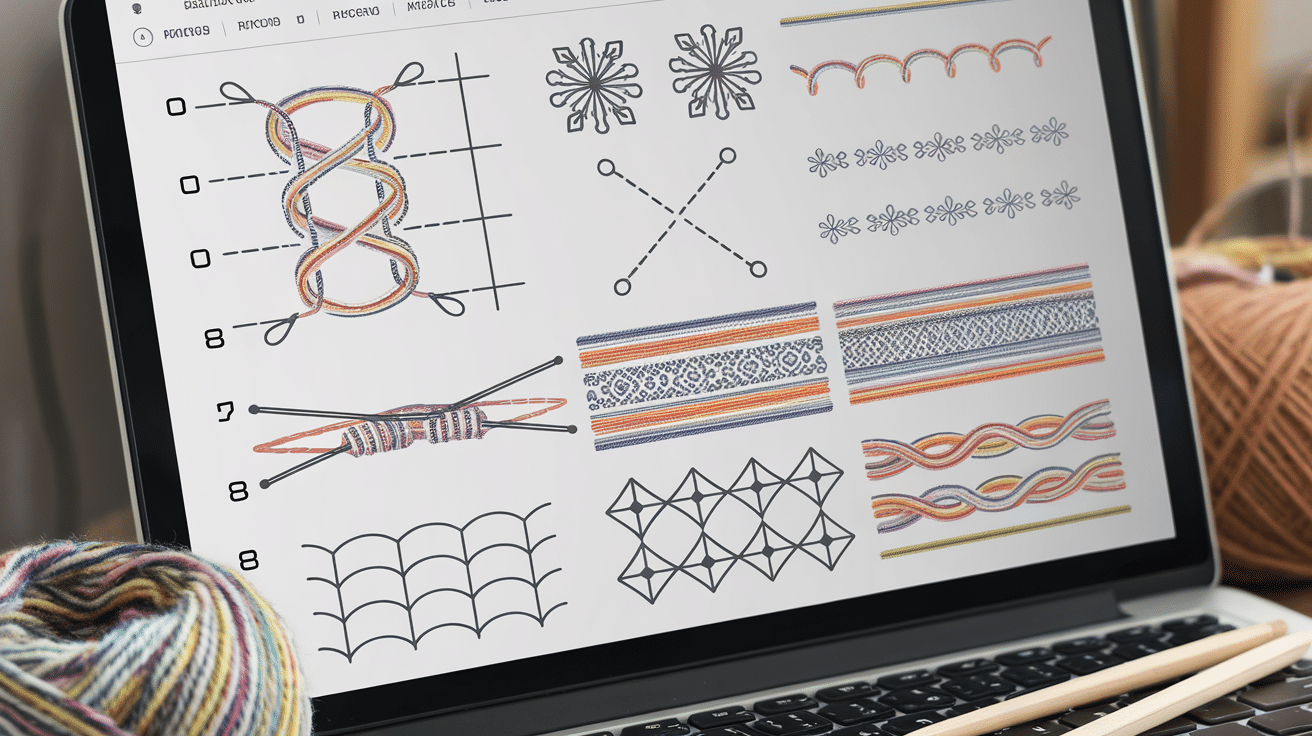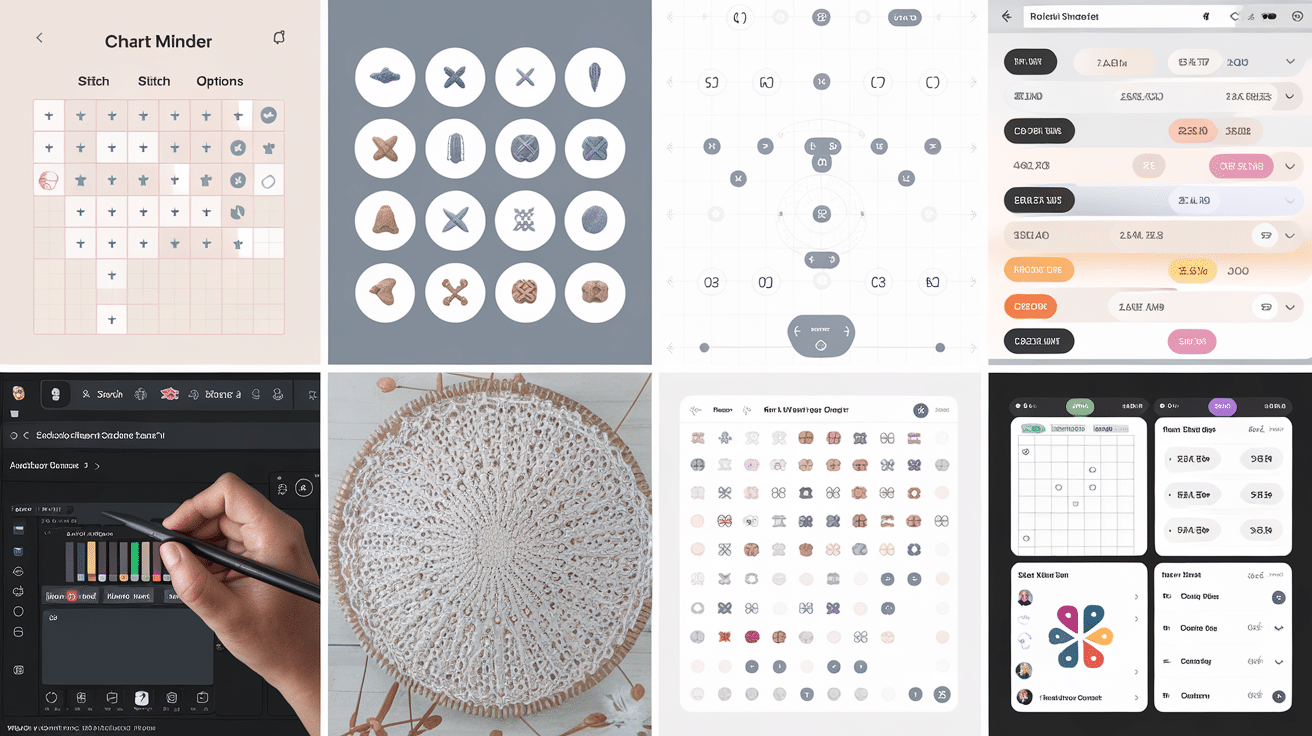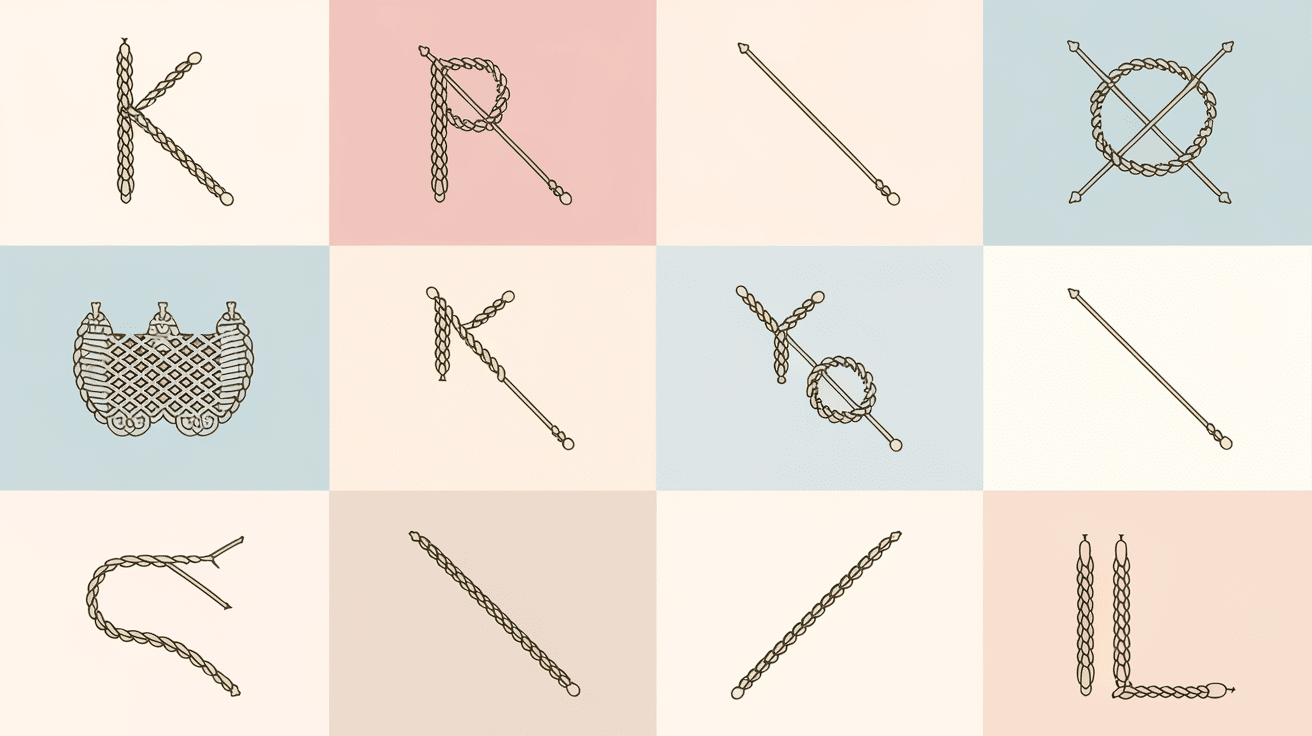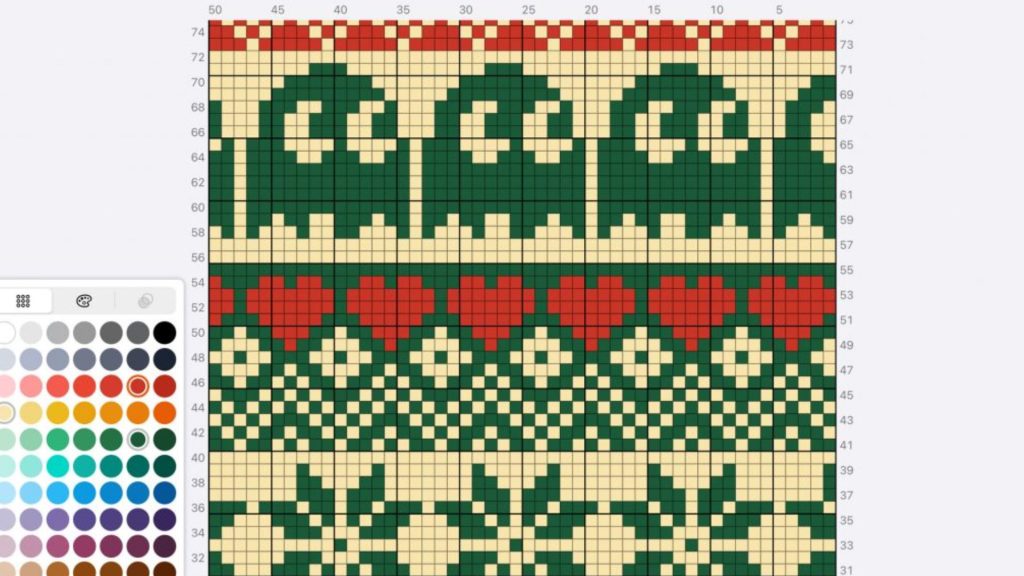If you love knitting, you know how important it is to follow patterns. But what if you could make your custom designs? That’s where knitting chart makers come in!
These tools help you create clear and easy-to-follow charts, turning your ideas into patterns you can use. Whether you’re a beginner or an experienced knitter, using a chart maker can save time and make your projects easier to manage.
You can choose from tools that let you customize everything from the stitch symbols to colors. With the right chart maker, you can share your designs with others or print them out for your next big project.
In this guide, I’ll talk about what knitting chart makers are, why they’re helpful, and which ones are the best for your next project.
Understanding Knitting Charts

Knitting charts are a great way to help you follow patterns, especially when working on more complex designs. Instead of reading written instructions, you can see the pattern laid out visually. These charts use grids, where each square represents a stitch in your project.
There are two main types of knitting charts: symbol charts and color charts. Symbol charts use different symbols to represent stitches, like knit stitches, purls, and increases. For example, a simple square might represent a knit stitch, and a circle might represent a purl stitch.
On the other hand, color charts are used when you want to include colors in your design. Each color is shown in a specific section of the grid. Whether you’re working with complicated patterns or simple ones, charts help you stay on track, making knitting a lot more fun and less confusing.
How to Choose the Right Chart Maker for Your Knitting Projects
When choosing a knitting chart maker, it’s important to pick one that fits your needs and makes creating charts easier. Here are some key features to look for:
1. Easy-to-Use Design: A good knitting chart maker should be simple to navigate. You don’t want to waste time figuring out how to use the tool. Look for a chart maker with an easy interface with clear buttons and options.
2. Customization Options: You’ll want a tool that lets you customize your charts. This means changing the grid’s size, choosing stitch symbols, and picking colors for your pattern.
3. Exporting and Sharing: A good chart maker should allow you to save your charts in different file formats (like PDF or JPEG). This makes it easier to print your patterns or share them with friends.
4. Preview and Edit Features: It’s helpful if the chart maker lets you preview your design before saving it. This way, you can catch any mistakes and make edits as needed.
Choosing the right knitting chart maker can make your projects easier and more fun. With the right features, you can create nice patterns with ease!
Top Knitting Chart Makers

Several knitting chart makers are available, each with its own set of features. Here’s a list of some of the best options you can look into.
1. Chart Minder
- Chart Minder is a simple, free tool that’s great for beginners. It allows you to create custom knitting charts by adjusting the grid size and adding stitches.
- You can choose from different stitch symbols and make knitting, crochet, and cross-stitch charts. One of the best things about Chart Minder is that it’s easy to use and doesn’t require any special skills.
2. Stitch Fiddle
- Stitch Fiddle is another popular chart maker. It’s an online tool that works well for knitting, crochet, and cross-stitch patterns. With Stitch Fiddle, you can create charts using a variety of stitch symbols and colors.
- It’s especially useful because it allows you to work with multiple crafts, so if you like to knit and crochet, you can use the same tool for both. One neat feature is that it lets you share your designs with a community of other crafters.
3. Knit Visualizer
- It’s a software application that lets you create professional-grade knitting charts. You can design charts using different stitch patterns, symbols, and even add notes to make sure everything is clear.
- Knit Visualizer also offers real-time previews, so you can see exactly what your chart will look like as you work on it. While it’s a paid tool, many knitters find it worth the investment for its extra features and flexibility.
4. Adobe Illustrator
- Although Adobe Illustrator isn’t a knitting chart maker, some experienced knitters use it to create custom charts. With its advanced tools, you can design detailed charts with total control over every aspect.
- You can use Illustrator to draw precise shapes, add colors, and even create unique symbols that might not be available in other chart makers. However, Illustrator has a bit of a learning curve, so it’s not the best choice for beginners.
5. Knitting Chart Generator
- The Knitting Chart Generator is another simple and easy-to-use online tool. It’s perfect if you want to create quick and simple knitting charts without any hassle.
- You can adjust the size of your chart, choose from a variety of stitch symbols, and customize the layout to suit your project. One of its great features is the ability to generate a chart from a written pattern.
6. Pixie Knits
- Pixie Knits is an online tool that is especially good for creating lace knitting charts. If you’re working on a lace project, Pixie Knits allows you to create charts easily.
- The tool features simple drag-and-drop functionality, so you can quickly build your chart and see how it will look. It’s great for both beginners and advanced knitters, offering enough customization to create a wide range of designs.
7. KnitPro
- It offers a variety of tools for designing and customizing your knitting charts. With KnitPro, you can choose from different stitch symbols, adjust the grid size, and even upload your own images to use as patterns.
- The tool also provides a useful feature for making multi-page charts, so you can design larger patterns that require more space.
8. Intwined Studio
- Intwined Studio is a powerful knitting software that’s designed for serious knitters. It lets you create custom charts for everything from simple stitches to complex cables.
- It also includes features like stitch charts, row counting, and automatic pattern generation. While this software is more advanced and requires a paid license, many knitters find it incredibly helpful for designing large, intricate patterns.
Each knitting chart maker has its strengths and works best for different needs. No matter which one you choose, these tools can help you turn your knitting ideas into reality with ease. Take some time to explore these options and find the chart maker that best suits your style and needs.
How to Make a Knitting Chart Using a Chart Maker
Creating a knitting chart using a chart maker is easier than you think! Here’s a simple, step-by-step guide to help you get started.
Step 1: Choose Your Chart Maker
First, pick a knitting chart maker that works for you. Some tools are online, while others are apps you can download. Popular options include Stitch Fiddle, Chart Minder, and Knit Visualizer. Make sure you pick one that feels easy to use and fits your specific knitting needs and preferences.
Step 2: Set Up the Grid
Once you’re in the chart maker, the next step is to set up your grid. The grid is where you’ll place your stitches. You can choose how many rows and columns you want depending on your pattern size. Most chart makers let you adjust the grid size easily.
Step 3: Pick Your Stitch Symbols
Next, it’s time to pick the symbols that represent the stitches you’ll be using. For example, a square might represent a knit stitch, and a circle might represent a purl. Most chart makers will let you select these symbols from a list. You can even choose symbols for special stitches like increases or decreases.
Step 4: Add Stitches to the Chart
Start filling in your grid with the stitches you want to use. Just click on the square in the grid, and the chart maker will place the stitch symbol there. Follow your pattern or create your own design by adding different stitch symbols in the right spots.
Step 5: Adjust the Colors (Optional)
If you want to add some color to your chart, many chart makers allow you to do this. For example, if you’re working on a colorwork pattern, you can color the squares to represent different yarns. This can help you visualize your project better and make it easier to follow when knitting with multiple colors.
Step 6: Save and Share
Once you’re happy with your chart, save it. You can usually download your chart as a PDF or image file. Some chart makers also let you share your chart directly with others or print it out while you knit. This way, you can keep a physical copy on hand while working on your project.
Creating a knitting chart is a great way to keep your knitting organized and help you easily follow patterns. Plus, it’s fun to see your ideas come to life in a chart!
Understanding the Types of Stitch Symbols in Chart Makers

When creating or reading knitting charts, understanding the stitch symbols is essential. These symbols represent the different stitches and techniques used in a pattern. Here’s a breakdown of the most common stitch symbols you’ll encounter in knitting chart makers:
1. Knit Stitch (K): A simple square or a filled-in square often represents the knit stitch. This is the most basic stitch in knitting and is used to create the fabric’s smooth side.
2. Purl Stitch (P): Purl stitches are often shown as an open circle or a small “o.” A purl stitch creates the opposite texture of the knit stitch and is typically used for the “wrong” side of the fabric or in patterns like ribbing.
3. Increase Stitches: Increases are often shown with a symbol like an upward arrow or a “+” sign. Increases are used to add stitches to your work, making the fabric wider. Different types include knit front and back (Kfb) or yarn over (yo).
4. Decrease Stitches: Decrease symbols are typically shown as slanted lines or a forward slash (“/”) for a right-slanting decrease and a backslash (“\”) for a left-slanting decrease. These symbols indicate when to reduce the number of stitches.
5. Slip Stitches: A slip stitch is often shown as an open circle with no fill. This involves moving a stitch from one needle to another without knitting or purling it. It’s commonly used in techniques like slipped stitches for color patterns.
6. Cable Stitches: Cable stitches, which twist your fabric for a textured look, are usually represented by an “X” or a similar twisting symbol. These stitches can be complex, and the chart often indicates which direction the twist should go.
7. Lace and Yarn Over (YO): Yarn overs (YO) are often shown as a small hole, typically represented by an open circle. They are used to create holes in lace patterns and add a light, airy texture.
8. Knitting Through the Back Loop (Ktbl): This stitch is shown as a symbol with a line crossing through the top of the square. It creates a twisted stitch, which gives the fabric a different texture and appearance.
9. Ssk (Slip, Slip, Knit): The “Ssk” decrease is often shown with two slanted lines pointing towards each other. It’s a left-slanting decrease commonly used in lace or shaping patterns.
10. Binding Off and Casting On: Some charts will include symbols to show where to bind off (BO) or cast on (CO) stitches. These symbols may be more specific, like a “V” for casting on or a “T” for binding off.
Each knitting chart maker will have a slightly different set of symbols, but they all follow these general patterns. Knowing these common stitch symbols will make it much easier to read and follow your charts, helping you complete your projects with confidence!
Helpful Tips for Effective Chart Design
Designing a knitting chart that’s easy to follow is key to having a smooth and enjoyable project. Here are some tips to help you create clear and effective charts:
1. Use Simple Symbols: Keep your symbols simple and easy to understand. Each symbol should represent a stitch. For example, use a square for a knit stitch and a circle for a purl stitch. This makes it easier to read and follow your chart.
2. Be Consistent: Stick to the same symbols and colors throughout your chart. Consistency helps you and others quickly recognize what each symbol means.
3. Add a Legend or Key: Include a key on your chart. This is a list of the symbols you used and what they represent. It’s especially helpful if you’re using special stitches or colors.
4. Keep It Neat: Make sure your chart is neat and organized. Keep the stitches lined up correctly in the grid and avoid overcrowding. If your chart looks messy, it can be hard to follow. Leave enough space between the symbols.
5. Check for Mistakes: Double-check your chart for any mistakes before you start knitting. It’s easy to accidentally place a stitch in the wrong spot, so reviewing your chart will help catch any errors before they become a problem.
6. Use Color for Clarity: If your design involves colorwork, using different colors on the chart can help you visualize the pattern. For example, use one color for the knit stitches and another for the purl stitches.
By following these tips, you’ll be able to design charts that are easy to read and fun to knit from!
Conclusion
Knitting charts are a great tool that can make your knitting projects easier and more fun. Whether you’re a beginner or an experienced knitter, using a chart maker can help you create clear patterns that are simple to follow.
By choosing the right chart maker, customizing your design, and using the tips we discussed, you can make charts that are both practical and enjoyable to work with.
Remember to keep your symbols simple, be consistent, and always check your chart for mistakes before you start knitting. With a little practice, you’ll be able to create your own custom patterns and share them with others.
Frequently Asked Questions
Are knitting chart makers free?
Some knitting chart makers are free, like Stitch Fiddle and Chart Minder. Others may require a paid subscription, offering more advanced features.
Can I use a knitting chart for crochet?
Yes, knitting chart makers can also be used for crochet patterns. Many tools allow you to switch between knitting, crochet, and other crafts.
How do I adjust stitch symbols in a chart maker?
Most chart makers allow you to customize stitch symbols. You can choose from pre-set options or add your own symbols.
Can I share my knitting chart with others?
Yes, most knitting chart makers allow you to share your charts easily. You can send them as images or PDFs and even share them on social media.
Can I modify an existing knitting chart?
Yes, most chart makers let you modify existing charts. You can import a chart, change symbols, colors, or stitch patterns, and adjust the layout.









